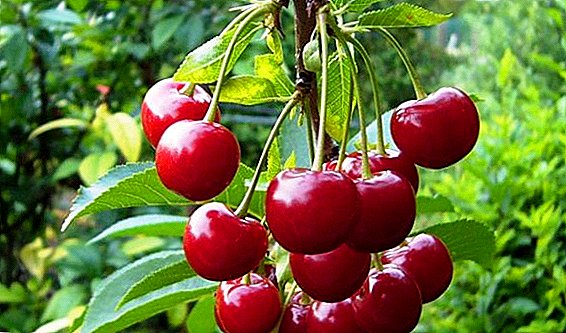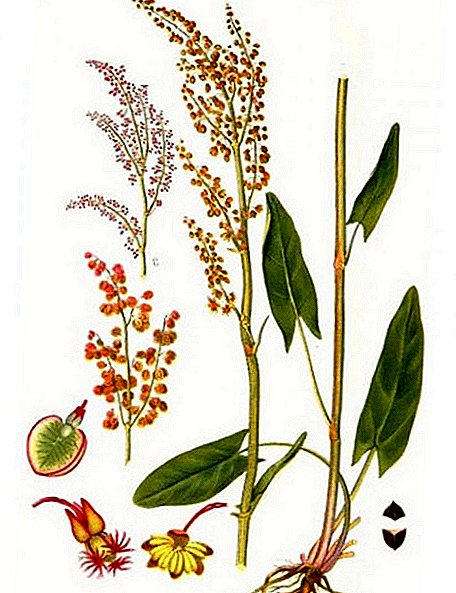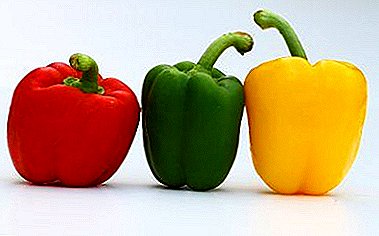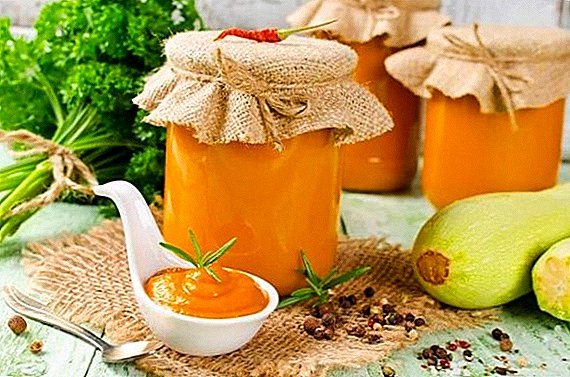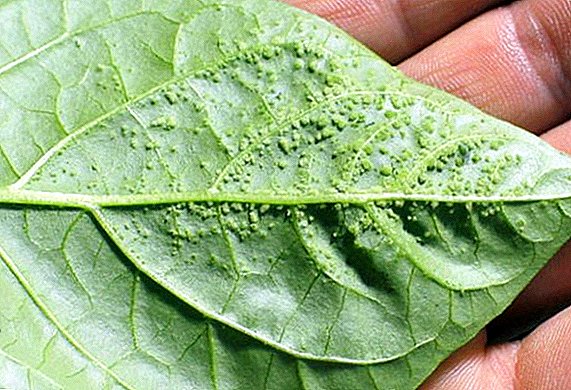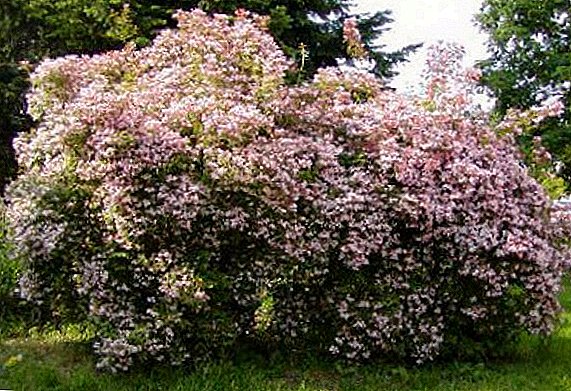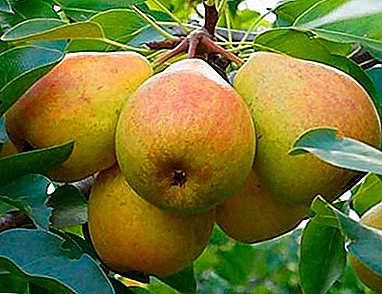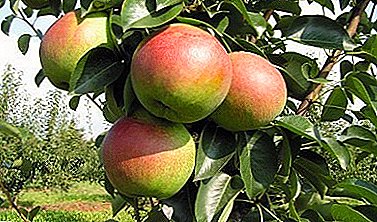
Although the pear tree occupies the third place after the apple and cherry trees, it appeared there as an overseas guest: it is thermophilic, sensitive to drought and frost, defenseless against fungal parasites.
According to the testimony of the literary works of ancient Hellas and the Sumerian medical treatises, this plant has been known to humanity for thousands of years, but the high point of the pear was the 18th century, when people began to think about the cultivation and assortment of this rose.
Features of selection selection
People's selection, unlike an apple tree, chewed its pear with attention, and there are several reasons for this:

- the existence of wild natural specimens, successfully used in medicine and eaten;
- the thermophilicity of the plant, which limited its range to 60 ° north latitude;
- discrediting the pear as a plant that is not resistant to early frost and scab affected;
- underestimation of the taste of fruits, due to their incomplete ripening under the conditions of a cool Russian summer and the presence of stony cells in the pulp, which are especially noticeable in unripe pears;
- an attempt to cultivate southern European varieties in domestic gardens.
Pear felt good in the Crimea, the southern regions of the Central Black Earth region, the North Caucasus. The efforts of the national breeders of Central Russia were aimed primarily at improving the taste of the fruit, and not at instilling in the emaciated plant characteristics that promote survival in harsh conditions.
In the Central Chernozem region, such pear varieties are excellent: Gera, Cathedral, Krasnobakaya, Krasulya and Lada.
Search for ways to create winter-hardy varieties of pears in our country began I.V. Michurin in the late 19th century. Subsequently successful were attempts to use as a stock Ussuri wild pear, having optimum stock of frost resistance (to - 30 ° C).
In each climate zone, scientific research institutes and fruit-growing centers were created to develop new promising hybrids. In 1937, one of them was a fruit and berry stronghold, created in the usual backyard area of the Voronezh breeder Ulyanischev.
Here, after the war, the Rossoshanskaya regional station was created (by the name of the district), where a new sort of pear, the Rossoshanskaya Dessert, was born.
 He was admitted to testing in 1952, and in 1975 he was included in the State Register and received a ticket to be distributed in industrial gardens. Belgorod, Voronezh, Kursk region and the North Caucasus region.
He was admitted to testing in 1952, and in 1975 he was included in the State Register and received a ticket to be distributed in industrial gardens. Belgorod, Voronezh, Kursk region and the North Caucasus region.
The name of the variety reflects the main purpose of the fruit - getting juicy sweet pears for fresh use as a dessert.
What kind of belongs
If the new variety was positioned as dessert, then in Voronezh, new forms were created that were more suitable for industrial cultivation:
- low or medium;
- high sugar levels in fruits;
- fruitful;
- suitable for long-term storage and transportation.
As universal rootstocks to obtain new garden varieties used natural pear forms typical of each region, with a long history of growth:

- Russian pear and 3 more of its species (Central Russia);
- Caucasian pear and its 24 forms (highlands of the Caucasus);
- Ussuri pear (Far East);
- snow pear (Central Asia).
Counting vegetative period for each hybrid, find the best option for a particular region, based on the time of ripening fruits:
- summer varieties - ripening is completed by the end of July; fresh shelf life of such fruits is limited to 10 days;
- autumn varieties - ripening occurs by the end of September; storage of fresh fruit without loss of taste is possible only in the refrigerating chamber for no more than 2 months;
- winter varieties - harvesting occurs in October; pears in storage reach consumer maturity; can be stored in the refrigerator until February.
Genetic base
The creation of a new hybrid form of a fruit plant involves the inoculation of a promising variety of consumer qualities to the rootstock adapted in the area.
For the "Dessert Rossoshanskaya" parent pair of steel pear varieties such as:
- "Bech (winter) Michurin" - winter varietycreated on the basis of the wild Ussuri stock, which gave it exceptional winter hardiness; fruits are small juicy, with 10% sugar content, slightly tart; during storage fruits mature; the main advantage is scab resistance, impressive yield, suitability for long-term storage; the variety has become the parent of another 50 new hybrids;
- "Forest Beauty" - autumn variety with a century of history from Belgium; good taste of thin-skinned fruits; keeping capacity - 3 weeks; fruiting is not stable, but high; winter hardy and drought resistant; parental pairs of another 30 varieties; vulnerable to scab.
If you are interested in disease-resistant varieties, pay attention to the varieties of Nick, Limonka, Victoria, Kupava, Cosmic.
According to the characteristics of the parent pair, it can be concluded that the derived variety will have what happened:
- high frost resistance;
- sweet taste;
- good product quality;
- the precocity of seedlings;
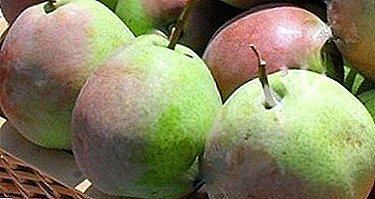 significant yield;
significant yield;- resistance to scab;
- undemanding of soil composition;
- suitability for use in breeding work.
Among the unpretentious varieties can also be distinguished Chizhovskaya, Yakovlevskaya, Nursery, Fairy Tale and the topic.
The disadvantages of the subsidiary form include the inheritance from the “Forest Beauty”, self-infertility and compulsory external pollination.
Interesting: To obtain hybrids with given qualities, it is possible to inoculate a pear not only on the stock of a wild-growing relative, but also on an apple tree, irgu, quince. In this case, it will be possible to form a pear like a palmette.
Description of the pear variety “Dessert Rossoshanskaya”
- Tree medium and large growth forces (10-15 m) with a pyramidal crown. Crown thinning determines the peculiarity of the plant to the weak formation of new shoots.
- The trunk and skeletal branches are gray and gray-brown in color.
- Young shoots of pears are characterized by substantial thickness and light brown color.
- Fruiting graft comes on the 5th year.
- Kidneys of two types: vegetative and generative. Differ in size and shape.
 The flowers are self-infertile, collected in inflorescences on medium-sized pedicels, with white (terry) petals, and occasionally with pink edging.
The flowers are self-infertile, collected in inflorescences on medium-sized pedicels, with white (terry) petals, and occasionally with pink edging.In the selection of pollinators, usually, are guided by the general timing of the flowering phase.
Such similarity is observed in varieties of pears "Marble", "Autumn Yakovlev" and "Tatyana".
- Fruits of medium size with a weak pear shape - more like apples. The skin is thin, in the period of maturity, yellow-green with a blush and rusty subcutaneous spots.
The flesh is sweet, juicy, with a delicate pear flavor. The quality of taste is influenced by the insignificance of the size of stony cells.
The color of pears for cutting is white-cream, the core is with a closed seed box and brown seeds. Evaluation of taste on the tasting scale - 5 points.
- Pear "Dessert Rossoshanskaya" characterized by high yield (up to 70 kg per tree). The average yield per hectare of industrial garden in different years is 120-300 kg.
- The ripening of the fruit occurs in time autumn varieties. Consumer maturity comes after the harvest.
- The fruits have universal application and are characterized by high commodity qualities, suitable for storage and long-distance transportation.
- This variety no scab pathogens, a great rarity - infection septoria.
- Winter hardiness of saplings as they move to the northern areas changes (high to medium). It is possible to strengthen the effect of winter hardiness of the variety by grafting even more frost-resistant pears into the tree crown.
Important: One of these trees must necessarily be in the garden next to the described variety, otherwise there will be no harvest, or the rare fruits that appear will be underdeveloped and of a defective type.
Interesting: The pear always seems to taste sweeter than an apple. This is not because its pulp contains more sugar, but because there are almost no acids in the pear, or they are present in meager amounts.

Autumn varieties also include: Svetlyanka, Perun, Samara Beauty, Bere Bosk and Larinskaya.
Good winter hardiness differ: Rogneda, Sverdlovchanka, Lel, Chudesnitsa and Chizhovskaya.
A photo
For more information about the variety and see the pears "Dessert Rossoshanskaya" can be in the photo below:





Fruit use
There are no great connoisseurs of pear fruit taste in the world than the French. In their national cuisine there are countless simple and complex dishes from this fruit. How to eat it with the greatest benefit and pleasure - they know best of all, too. Here are the recommendations, in their opinion, should be followed:

- only juicy and sweet fruits belonging to dessert varieties are eaten fresh (hard industrial varieties in their raw form can cause indigestion, it is better to bake them);
- the dessert pear is not peeled, as the skin has the most fiber;
- pears are not eaten immediately after a meal or on an empty stomach: the rules require to wait 30-40 minutes between meals;
- useful volume of pear fruits - 2 pieces in one step, or 1 pear + 1 apple, or 1 pear + 3;
- like other sweet fruits, pears should not be washed down with carbonated drinks or immediately switch to meat-rich dishes;
- pears will have to be abandoned by people with acute gastritis or peptic ulcer disease, as well as those suffering from constipation;
- low calorie pears make them the preferred fruit for dieters; It is efficient to carry out “pear” fasting days when 1-2 kg of pears are eaten in three doses;
- people over 40 will benefit from the vitamin set of these fruits and the folic acid they contain;
- The invigorating and tonic effect of pears begins with the perception of their flavor, which is why it is advisable to eat pears grown in your region, and not an imported product (processed with preservatives for long-distance transport).
Tips to host
- Pear does not like transplantstherefore, she needs to immediately identify the most sunny and protected place in the garden. In addition, it should be taken into account when planting that the crown of a tree increases by 30-40 cm over the year.
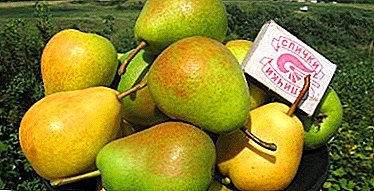 Protecting from spring thawed snow, the plant must be planted on an artificially created moundby raising above the general level of landings.
Protecting from spring thawed snow, the plant must be planted on an artificially created moundby raising above the general level of landings.- Caring for the variety "Dessert Rossoshshanskaya" is no different from the requirements of agrotechnology for pear trees of Russian selection: pruning, watering, fertilization, preventive spraying.
- Do not expect to propagate this variety with seeds: everything will have to be planted sooner and later. It is better to immediately take a strong stock with a good heredity and conduct a poll (eye inoculation).
- The crown of a pear tree gives a good shade, therefore it is advisable to plant it in a recreation area: above a bench or a gazebo.


 significant yield;
significant yield; The flowers are self-infertile, collected in inflorescences on medium-sized pedicels, with white (terry) petals, and occasionally with pink edging.
The flowers are self-infertile, collected in inflorescences on medium-sized pedicels, with white (terry) petals, and occasionally with pink edging. Protecting from spring thawed snow, the plant must be planted on an artificially created moundby raising above the general level of landings.
Protecting from spring thawed snow, the plant must be planted on an artificially created moundby raising above the general level of landings.